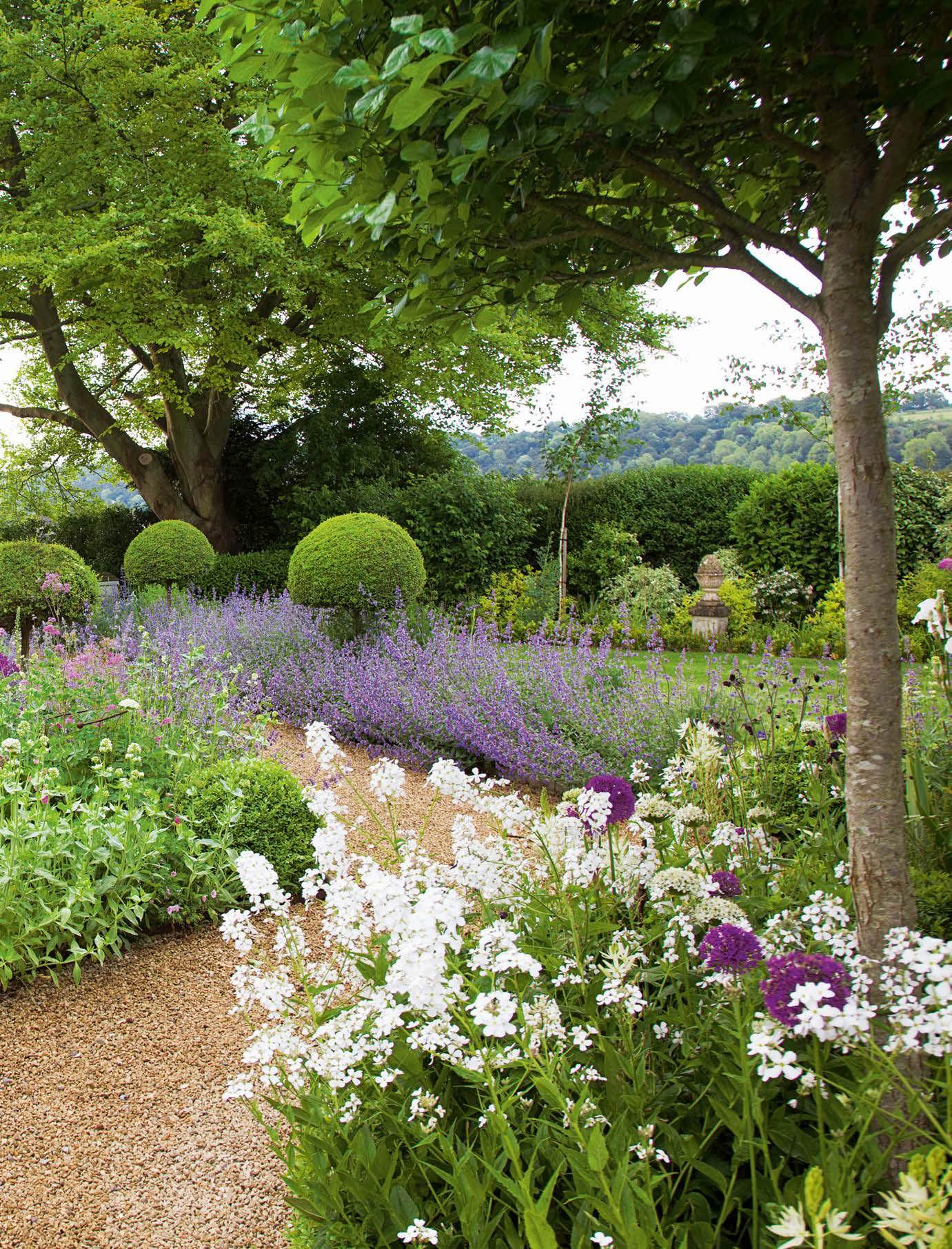
19 minute read
Ordnance House This spherically inspired
At times Terry and Vanessa Winters’ garden seems rather like an opera set, with every detail in exquisite order. You can almost imagine the singers coming through arches to regale you with a Puccini chorus. In the main garden you find yourself lost amid a mass of blossom and spheres, some on the ground; some like balloons held aloft on helium. These are repeated everywhere, and are pure theatre.
The original Ordnance House was part of a Royal Navy Ordnance Depot constructed in the late 1930s. This was pulled down and the present Ordnance House erected in 2008. It never had a garden as such: topsoil was minimal, and when Terry and Vanessa arrived in 2011 they were apprehensive. Having previously gardened on clay, they were now dealing with chalk soil – usually regarded as difficult, dry, stony, lacking nutrients and humus, and inhospitable to rhododendrons, azaleas, camellias, heathers, and a host of other plants that flourish only in acid conditions.
Terry, a design consultant, did not rush the process. He knew they had to focus on specific plants that would grow well in alkaline soil, and did his research carefully. Then came the plan. The house looks south to a low hedge with woods and rolling Wiltshire downland beyond. A roundel was designed as the garden’s central focus, to be viewed from the main sitting room and any path entering the garden. From the roundel paths stretched off, creating beds and leading to a gazebo and small orchard. In two areas of the garden, planting pits were created in the hard white chalk, which were then filled with decent topsoil and compost to supply the necessary humus that chalk soils lack.
In fact, Terry soon discovered plenty of positives to gardening on chalk. The soil drains rapidly and can be worked after even the heaviest of downpours. In the depths of winter, the ground never gets soggy. In their previous garden on clay they lost lavender and some other perennials to cold and damp, but here, not one. Because plants’ roots don’t get waterlogged in winter, here they happily survive.
At the centre of the focal roundel, are four hawthorns, Crataegus prunifolia, shaped to become a floating cloud in May. This rounded form is repeated below by four large box balls and
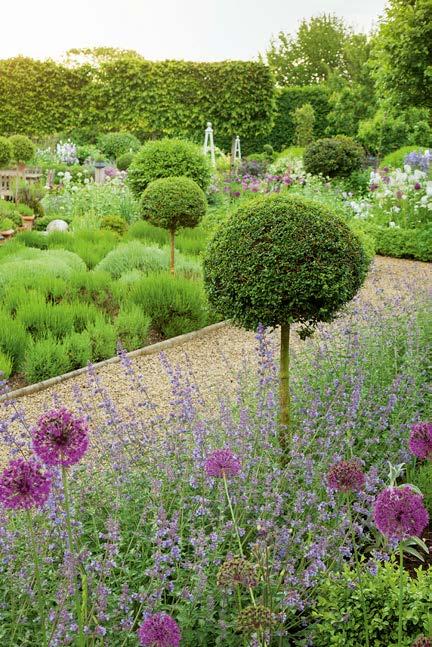
Right White alliums and bearded iris opposite a curving arc of catmint. Bottom right Encircled by circles, Prunus lusitanica standards. Bottom left Beautifully shaped Pyrus calleryana ‘Chanticleer’ line up between the house and the rest of the garden. Below Clipped globes of box appear to float above an underplanting of allium and catmint.
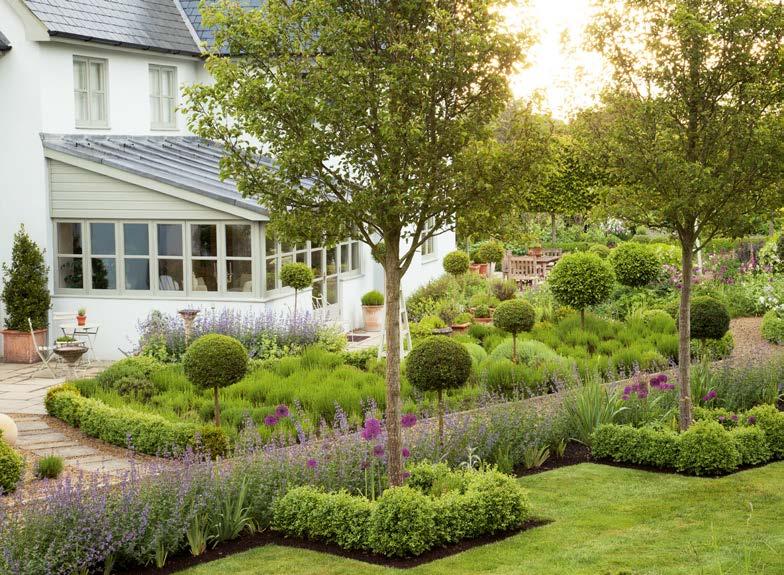
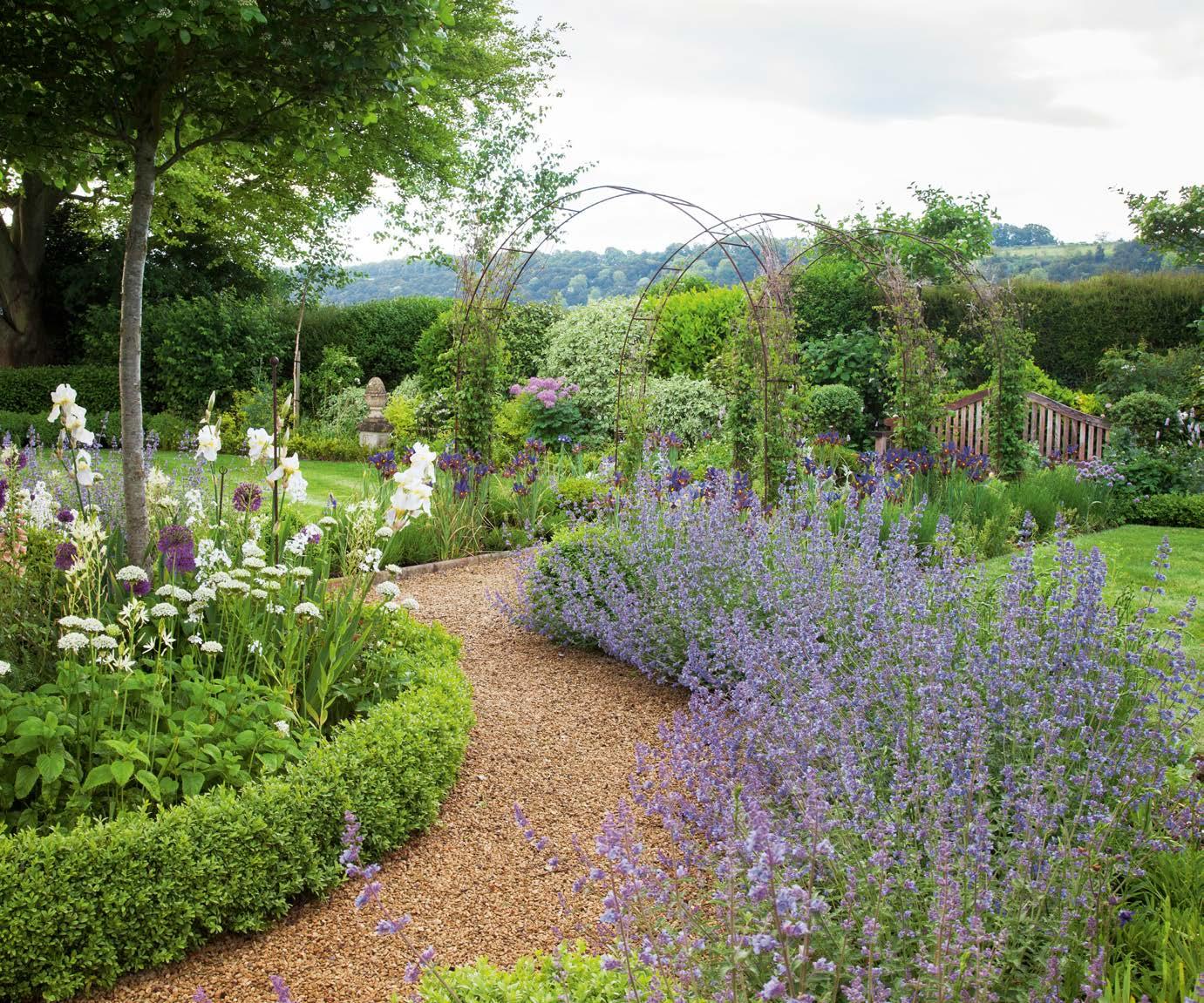
Allium hollandicum ‘Purple Sensation’, white A. nigrum and A. stipitatum ‘Mount Everest’ backed by swathes of Nepeta racemosa ‘Walker’s Low’ and sweet rocket. Low box hedging surrounds the roundel and other beds, giving a pleasing sense of definition. Alliums are brilliant garden plants, standing erect and never needing staking and, once their glory days are over, fading quietly away.
In June the lavenders start blooming. First, come L. angustifolia varieties such as ‘Blue Ice’, ‘Hidcote’, ‘Arctic Snow’ and ‘Nana Alba’, followed by the intensely scented L. x intermedia varieties like ‘Sussex’, ‘Grosso’ and ‘Gros Bleu’. These continue into September, and the garden hums with activity as insects forage for nectar. “The bees go mad,” notes Vanessa. Terry’s one piece of advice for lavender is to cut it back hard after flowering, but not into dead wood, allowing about three centimetres to

grow before the November frosts. This creates small globes of neatly trimmed lavender balls.
Along the path beside the house grow three ornamental pears, Pyrus calleryana ‘Chanticleer’, which grow naturally into a pyramidal shape, echoing other cones in the garden. Colours through the garden, meanwhile, are whites, purples and blues, the latter ranging from the deepest blue of iris, through the softer tones of scabious and nepeta, to pale lavenders arrayed like sky pools by the green standard spheres of topiary. There’s a lovely airiness and grace to this garden; it seems to reflect the light.
As the season moves into high summer, reddish tones come through, including the bruised redmauve of the oriental poppy ‘Patty’s Plum’, and foxgloves, which grow and self-seed in one of the planting pits. When planting perennials, Terry puts groups of the same variety in drifts together for unified impact, avoiding the patchwork effect that comes from dotting plants around.
Come June, white rambling rose ‘Wedding Day’ blooms over an arch and by August, Clematis ‘Purpurea Plena Elegans’, a mauve, double Viticella grown since Elizabethan times, winds over rusted arches. Each February a ‘Valentine’s Day Massacre’ is inflicted and the clematis is cut to the ground.
The hedging and topiary here is the classic Buxus sempervirens. Box blight, spread by spores, has ravaged box throughout the country, causing many gardeners to rip it out and plant usually less satisfactory alternatives. Terry points out a small, barely noticeable patch on a hedge: “The essential thing is never to cut or clip in damp muggy conditions. Keep the airflow open, and never let

Colours range from deepest blue of iris to pale lavenders arrayed like sky pools by the green standard spheres of topiary
Above All of the garden’s neatly gravelled paths lead to the central circular bed, full of irises and alliums in late spring. other plants flop over it. Dome shapes are less conducive to settling rain.” Much of his trimming is achieved by tipping, leaving a slightly woolly shape to discourage the blight. When clipping, to prevent the chance of cross infection, he dips his shears in disinfectant when moving between beds. Box moth? To date, he has not been troubled.
The balls and occasional cones that are such a feature of the garden come not only in box but yew, Thuja ‘Tiny Tim’, privet and Viburnum tinus ‘Eve
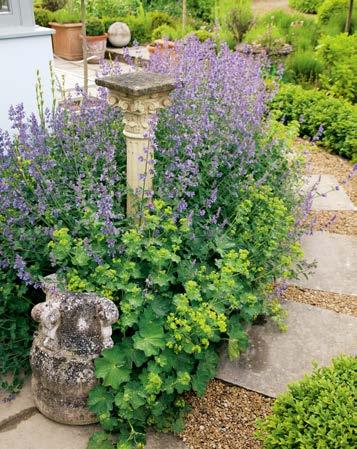

Top White centranthus joins Allium ‘Purple Sensation’ and clipped globes of choisya. Above Catmint and Alchemilla mollis soften the hard edges of a path. Left The vegetable plot features rows of chives and colour-coordinated lettuces, all contained by low box hedging. Price’, and are repeated in stone and pottery. The dark shining standards of Portuguese laurel are particularly handsome and echoed in hedging. The standard globes of Choisya x dewitteana ‘White Dazzler’ were propagated at nearby Longstock Park Nursery. Immaculate double cordons make a fruiting fence of the apples ‘Egremont Russet’, ‘James Grieve’ and ‘Katja’, and separate the orchard from the main garden. The vegetable garden has raised beds with lettuce, potatoes, Swiss chard, carrots and peas. Many of the plants Terry grows are propagated from cuttings, including the eight varieties of penstemon that will eventually find their way into the main garden. All planting in the main herbaceous bed was bought as small plants in 9cm pots and, says Terry, these grew far better than larger more expensive plants. Across the garden in a small, soft-fruit area are bays for compost – no plant material is discarded.
Where do Terry’s ideas come from? Chelsea Flower Show is one source of inspiration, and when

he likes a certain show Above Plummier tones garden he jots down in this bed come from names of individual Geranium phaeum ‘Samobor’ and darkplants and notes how leaved Sambucus nigra. they are used. Tom Right A crop of healthy Stuart-Smith is one potatoes burgeons in the garden designer he vegetable garden, which is separated from the particularly admires, ornamental area by and Euphorbia pleached hornbeams. griffithii ‘Fireglow’ and Geranium phaeum var. phaeum ‘Samobor’ are just two of the plants he has ‘borrowed’ from Chelsea.
Terry Winters may draw inspiration from other gardeners, but this garden is very much his own creation. The planting is controlled, with an attention to detail that at times seems almost French or Japanese in style, but among the spheres, cones and low hedging, the outpouring of blossom through the spring months gives the place an unworldliness – an ethereal quality that comes only from an English chalk garden. n
Ordnance House, West Dean, Salisbury, Wiltshire SP5 1JE. The garden normally opens by appointment to groups of 20 people or more, with a National Garden Scheme open day planned for 23 May 2021. Visit ordnancehouse.co.uk for updates.


Topiary, mature trees and a cloud-pruned osmanthus lend this vicarage garden an established feel.

The Grown-up GARDEN
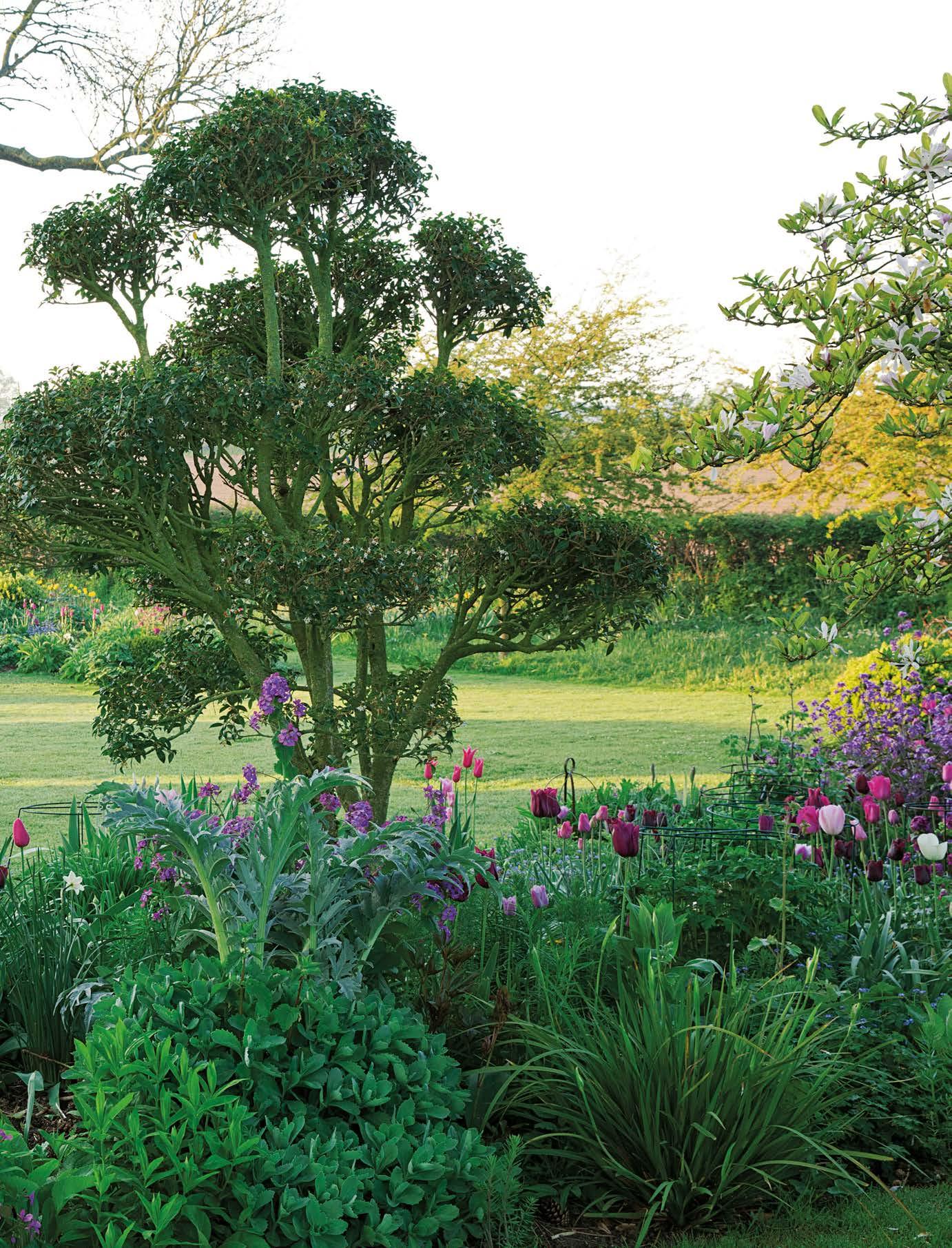
Over 36 years, the ambitious garden at Glebe House in Monmouthshire has matured into comfortable success, filled with shape and structure – and masses of tulips
Glebe House was a vicarage until it was sold off by the Church in the 1960s, and it came with a thoroughly disreputable garden rich in empty bottles. Its new owners got a grip on it and created a pleasant enough country garden. In their later years they received a letter from Murray and Joanna Kerr, then renting a property nearby. “If ever you want to sell it,” wrote Joanna, “we would love to have first refusal.” A couple of years later Glebe House and an acre and a half of land was theirs. With rich red soil in the Vale of Usk and with views over undulating wheat fields to the picturesque Black Mountains of eastern Wales, it was a good place for three children to run around and not a bad place to start a garden.
That was 36 years ago. Today there is a much more ambitious garden, set around all four sides of the house, each side bearing a character of its own. Trees that were planted then for shelter and privacy – birch, Corsican pine – are now nicely mature. It feels as a vicarage garden ought to feel: comfortable, well-loved and established.
Glebe House was not Joanna’s first garden. “I learned my gardening on a long thin strip behind a Berkshire semi and then on a bigger one with plenty
Box clipped into humpy-bumpy rhythms morphs sweetly into the contrasting texture of clipped santolina

of apple trees in Wiltshire,” she says. She was happy then to put much of her energy into vegetables, but, at Glebe House, there is a bigger canvas to work on.
On the western, road-side of the house she made a sober garden of greens that is a quiet introduction to more colourful planting beyond. There are smart holly hedges and topiary here, a great mushroom of yew made from the shoots that have grown out from the stump of a felled tree, and plenty of box, which is clipped into humpy-bumpy rhythms and morphs sweetly into the contrasting texture of the clipped, green-leaved santolina.
Get Joanna talking about gardens and she plunges straight into plants and colours and the best varieties and what goes well with what. The fact is, she has given herself plenty of opportunity to learn far beyond the scope of those first two gardens. She studied propagation at Pershore College of Horticulture for a short time, and when in 1987 Catriona Boyle set up her Gardening School at Abergavenny a few miles away, Joanna joined her to
Box ball full stops help anchor breezy spring borders of tulips with early-flowering honesty and coronilla.
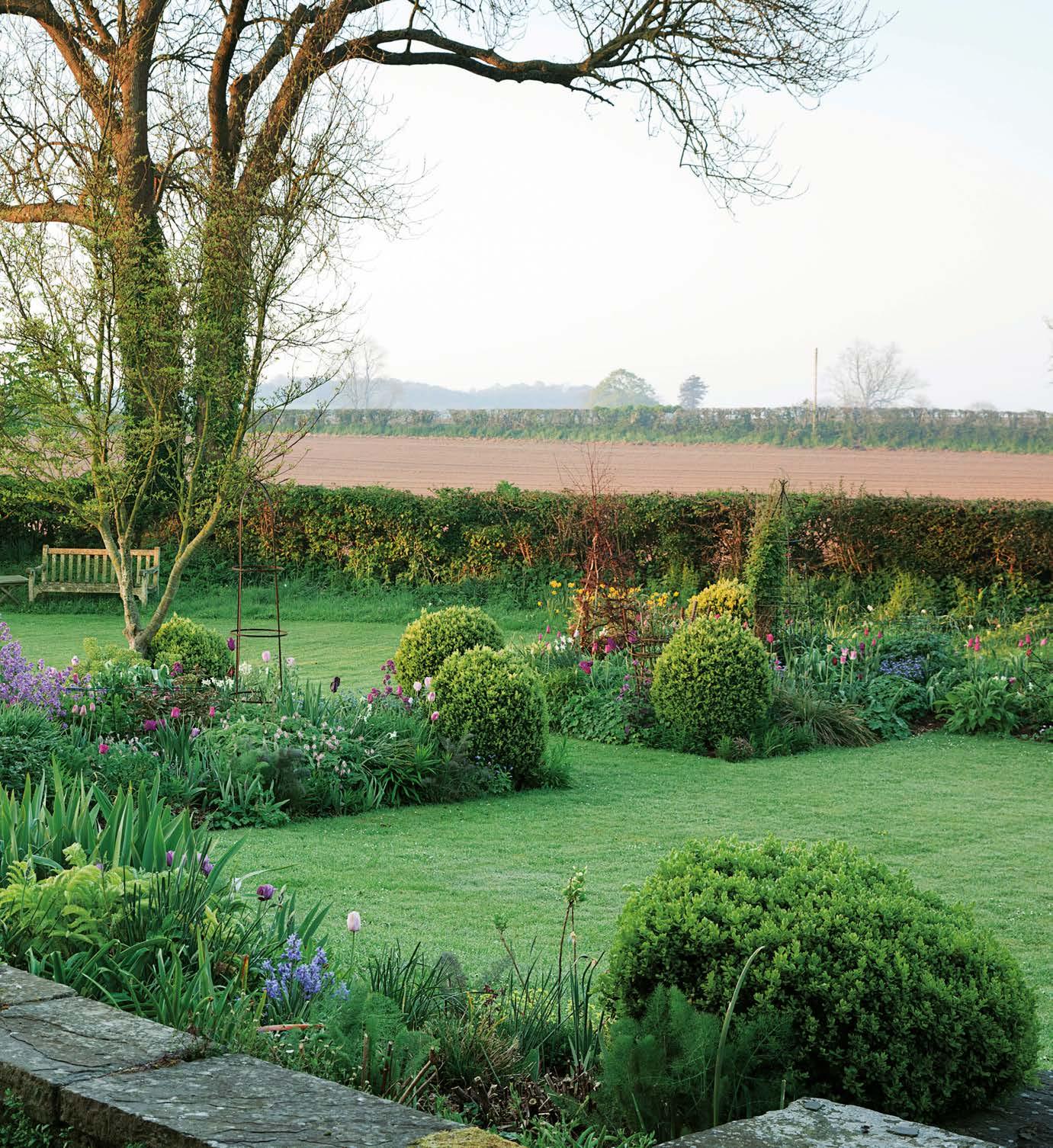
Spires of Camassia leichtlinii and lime-green Smyrnium perfoliatum add zing as this border bursts into spring growth.
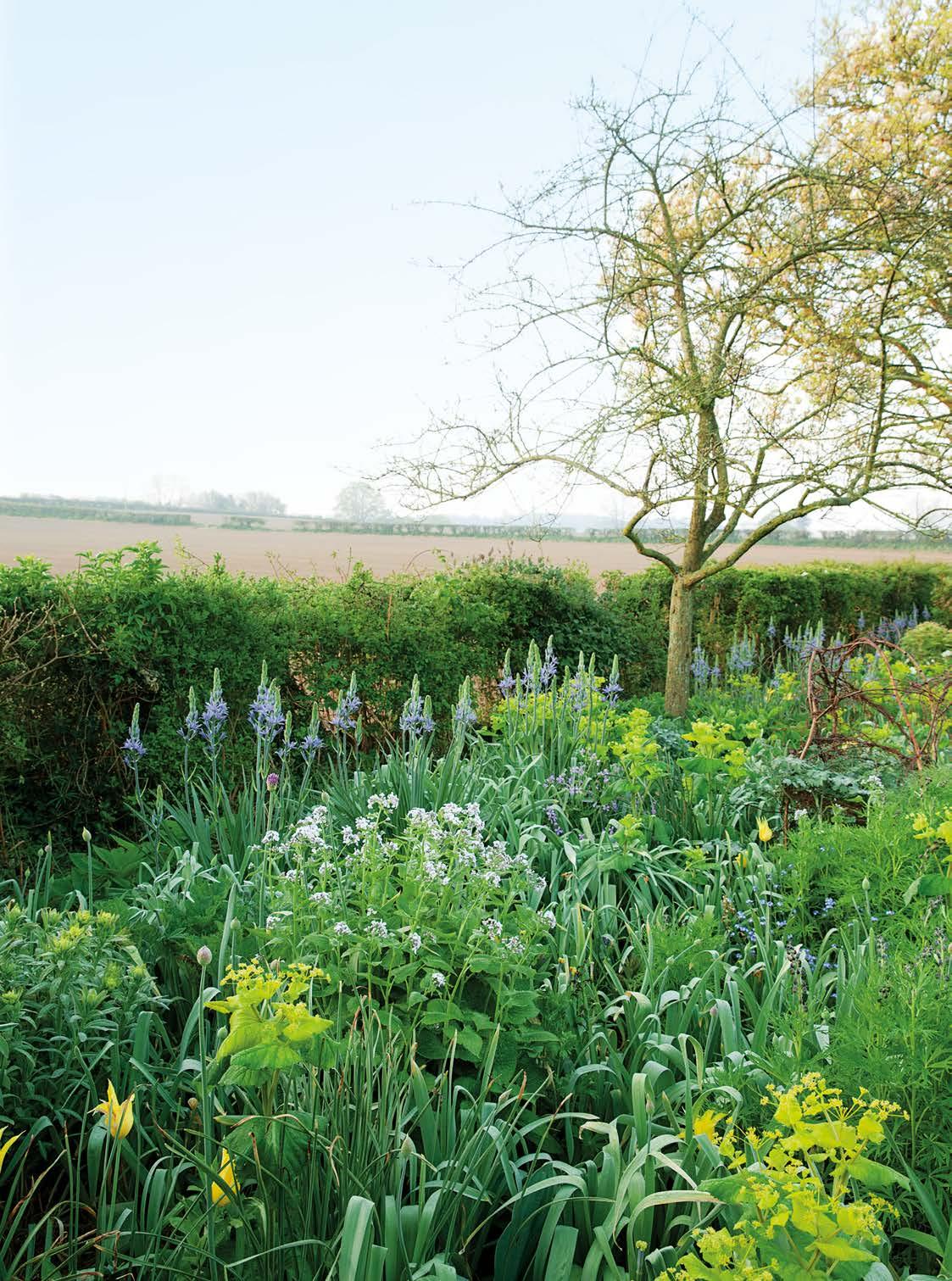
Spring perfection: a pink-blossomed cherry hangs over the path that winds its way around one of the pools.
Paths wind through grow and sell plants to students and locals. “I love propagation, meadow grass that, in spring, is spangled with and we wanted to sell plants that weren’t available elsewhere: new good things that we wanted to snowdrops, crocuses, grow ourselves.” The school ran until 2006, by which time Joanna chionodoxas and iris had become County Organiser for the National Garden Scheme and was busy visiting and vetting the many gardens that offered to open for the scheme. It was a demanding job that she performed with pleasure for 20 years. In 2019 the county made well over £50,000 for nursing charities. Glebe House has been opening for the Scheme for many years, usually in spring for the bulbs that Joanna uses throughout the garden. To the north of the house is an orchard, where grass paths wind Left The bright purple flowers of biennial through meadow grass that, in spring, is spangled honesty, Lunaria annua, with snowdrops, crocuses, chionodoxas, Iris are a classic choice for reticulata, scillas, snake’s head fritillaries and more. rich spring colour. Cowslips, narcissus and bright red tulips follow on Below Under the fruit trees, paths are mown in the long grass under apples, pears and a superb through a meadow of specimen of the dogwood Cornus ‘Eddie’s White tulips and cowslips. Wonder’. The blue quamash, Camassia quamash,

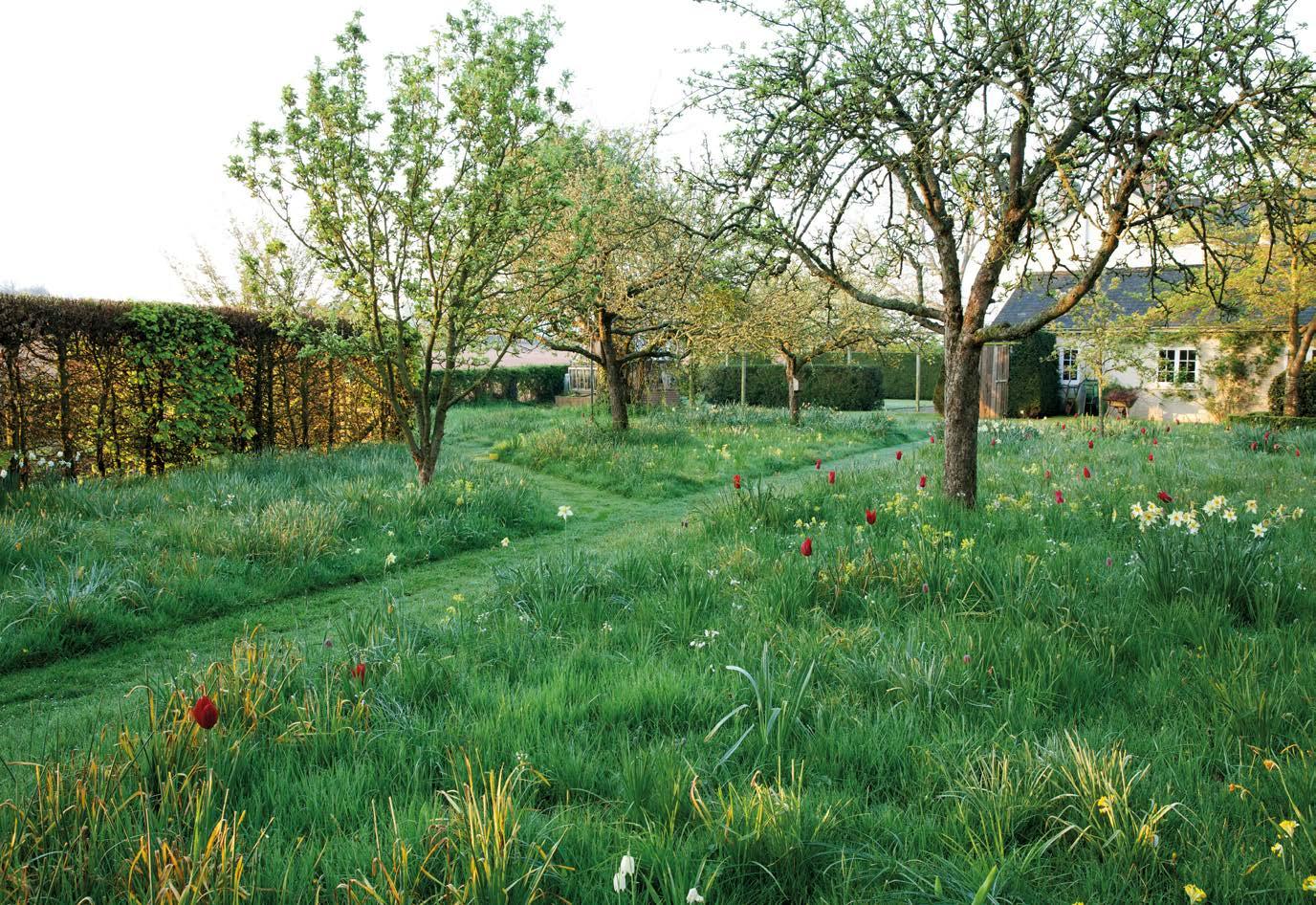
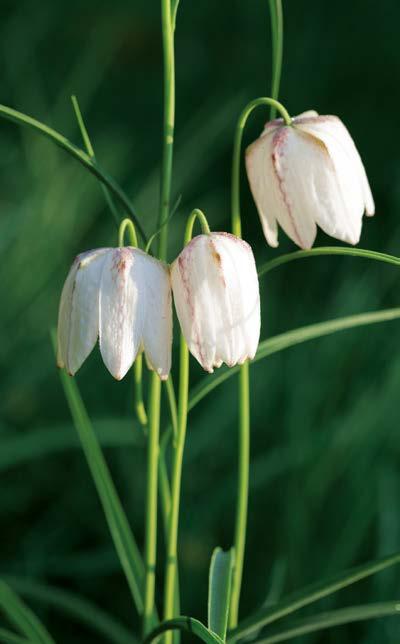
Right The wisteria on the house came from the famous specimen that grows on Usk prison. Bottom right Allow cowslips to self-seed before mowing areas of meadow for more of their dainty flowers. Bottom left Woven willow adds a focal point in this sweeping border. Below White fritillaries spring up in the meadow grass; they are best suited to damper soil.

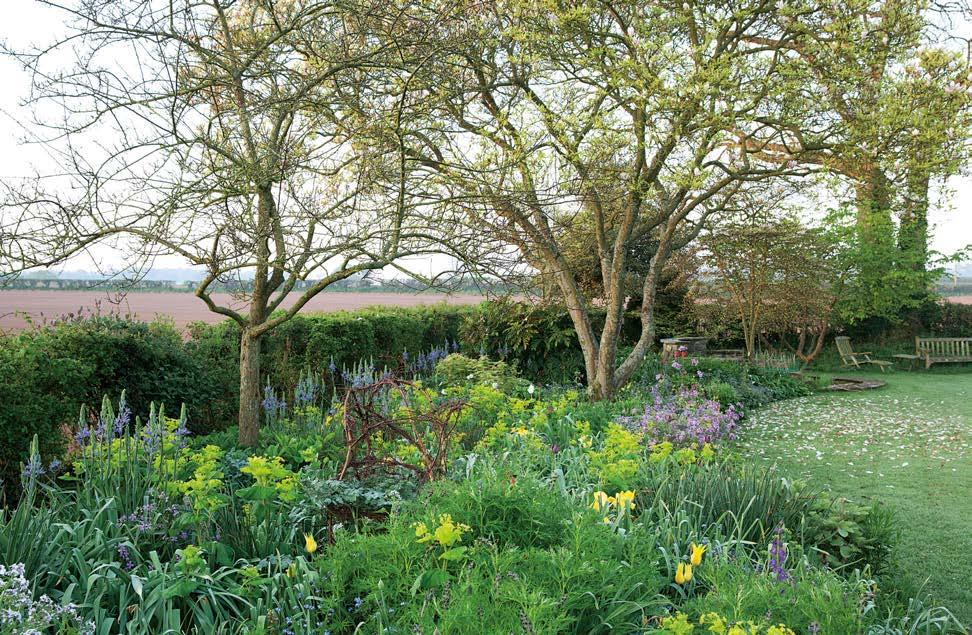

Companions FOR TULIPS Joanna shares her recommendations for perfect plants to grow alongside these spring bulbs

Tulips in borders never look their best when rising from bare soil. Joanna tries to plant them where they will stand out among early groundcover or in close proximity to soon-to-be-tall, leafy summer fl owers – cardoons or aquilegias, for example – that hide both the soil and some of the bareness of the tulips’ stems. Her most successful companions include tall alliums, daylilies, irises, aquilegias, vigorous euphorbias, geraniums, catmint, cardoons, forget-me-nots and sedums. Since these plants are not yet in fl ower, Joanna is free to change the colour of her tulip varieties from year to year without causing colour clashes. is planted here because its smaller stature makes it appear more at home in rough grass than the taller Camassia leichtlinii.
Just over the orchard hedge is a formal vegetable garden divided by grass paths, and then comes the garden headquarters: a frost-free greenhouse where all kinds of tender plants can be propagated and overwintered for use in summer pots, including aeoniums, scented-leaved pelargoniums, and salvias. But the greenhouse marks the end of the productive parts of the garden. Now comes a long line of wooden arches, like half a pergola, which Joanna is very pleased to call their ‘Kerrgola’. On this grows an excellent white wisteria and, like a hedge beneath it, is a running row of myrtles that cope pretty well in the cold, some years turning leafl ess but rarely damaged further. A further purple wisteria grows on the house. “It came from the one at Usk and fl owers properly before the leaves open, so you see the fl owers very clearly,” Joanna explains. The wisteria she is referring to is locally famous: it is vast and grows along the walls of a grand 19th-century prison there. What a picturesque escape route!
The main fl ower gardens now wrap around the east and south sides of the house, which sit on a generous stone terrace delightfully invaded by the little Mexican fl eabane, Erigeron karvinskianus, and built to replace the mean strip of paving that previously ringed the house.
Steps were built to lead down onto the lawn, with topiary pieces top and bottom and a cloud-pruned Osmanthus burkwoodii to give them gravitas. At either end of the terrace clipped yew wings attach the house to its garden. “We had some odd, lozengeshaped beds down there,” says Joanna, “but Helen Dillon came and said we should scrap them and relate the space much more to the house.” So new beds were made, this time in line with the house.
How does Helen Dillon, that great Irish gardener and writer, happen to have been there? Because she was a lecturer at the garden school: “I learned so much,” says Joanna. “We had 14 lecturers a year there, for 15 years – it was wonderful.”
The fl ower gardens today dazzle with colour, thanks both to her own e orts and those of her sixhours-a-week gardener, Linda Harrington. On the shadier side, under a fi ne Magnolia x soulangeana,
Standout TULIPS A selection of the high-performing tulip cultivars Joanna returns to year after year
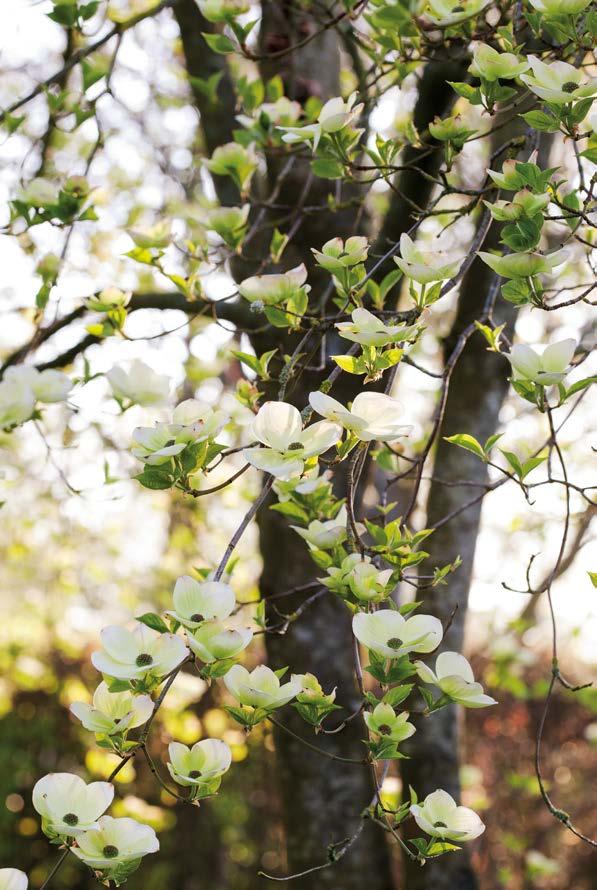
a ‘blue, purple and Above The green-white yellow’ border is packed flowers of Cornus with more snowdrops, ‘Eddie’s White Wonder’ create an eye-level hellebores, Camassia spectacle each spring. leichtlinii, Euphorbia palustris, perennial and biennial honesty (Lunaria rediviva and L. annua) and tulips. Smyrnium perfoliatum adds a dash of lime to set them off. To the rear, country hedges of thorn and holly lead on to rolling wheat fields and a wooded ridge beyond.
Tulips abound – clear yellow ‘West Point’, ‘White Triumphator’, ‘Pink Diamond’, the velvety, dark maroon goblets of ‘Queen of Night’, cream ‘City of Vancouver’, pink and green ‘Florosa’ and many more – and of course now, once the tulips are in full fling, summer cannot be far behind. n
Glebe House, Llanvair Kilgeddin, Abergavenny, Monmouthshire NP7 9BE. Usually opens in spring for the National Garden Scheme, but check the website for updates on opening. ngs.org.uk
The long petals of this clear yellow tulip are elegantly pointed. Flowers from late April to May on 60cm stems.
Rich red flowers, with petal mid-ribs in a slightly darker shade. Flowers in late April and May on 40cm stems.


‘DON QUICHOTTE’
Magenta flowers in late April and early May add vibrancy among spring’s green foliage. Grows to 55cm tall.
‘TRÈS CHIC’
A lily-flowered tulip with an elegant shape, which blooms from late April to mid May and grows to 45cm.
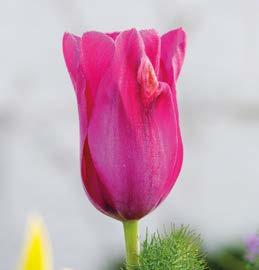
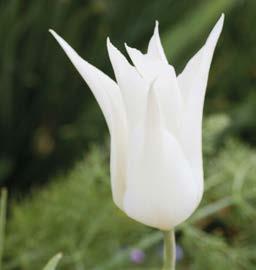
A classic choice for dark, blooms that contrast well with pastels. Flowers from late April and reaches 60cm.
‘ROSALIE’
Pale pink with subtly feathered petals that fade to white at the edges. Flowers throughout April and grows to 45cm.
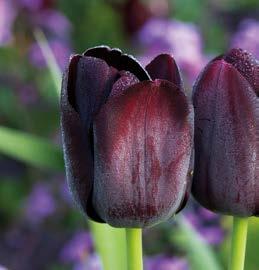
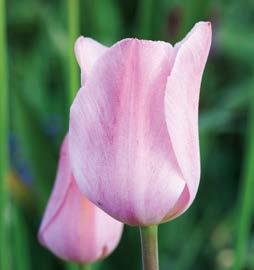
Lunar Calendars of the Pre-Columbian Maya
Harvey M. and Victoria R. Bricker Transactions of the American Philosophical Society Volume 109, Part 1 $37 • Paperback ISBN: 978-1-60618-091-4
John Milton’s Roman Sojourns, 1638–1639: Neo-Latin Self-Fashioning
Estelle Haan Transactions of the American Philosophical Society Volume 109, Part 4 $37 • Paperback ISBN: 978-1-60618-094-5 Spreading the Word: Scottish Publishers and English Literature 1750 –1900
Lionel Gossman Transactions of the American Philosophical Society • Volume 109, Part 2 • $37 • Paperback ISBN: 978-1-60618-092-1
Art, Science, Invention: Conservation and the Peale-Sellers Family Renée Wolcott Transactions of the American Philosophical Society • Volume 108 • Part 1 • $37 Paperback ISBN: 978-1-60618-081-5 Biblioteca Angelica ms. 1551 and the Origins of Ethnohistorical Illustration of Asia and the Americas Around 1600 in Rome

Barbara C. Anderson Transactions of the American Philosophical Society • Volume 109, Part 3 • $37 Paperback • ISBN: 978-1-60618-093-8
John Laurance: The Immigrant Founding Father America Never Knew
2019 John Frederick Lewis Award winner
Keith Marshall Jones III Transactions of the American Philosophical Society • Volume 108 Part 2 • $37 • Paperback ISBN: 978-1-60618-082-2
John Beale Bordley’s Necessaries: An American Enlightenment Pamphlet in its Historical Contexts
American Philosophical Society Transactions of the American Philosophical Society • Volume 108 • Part 3 • $37 • Paperback ISBN: 978-1-60618-083-9 A Life for Water: A Memoir
Luna Bergere Leopold Transactions of the American Philosophical Society Volume 108 Part 4 • $37 Paperback ISBN: 978-1-60618-084-6 Season of Conspiracy: Calvin, the French Reformed Churches, and Protestant Plotting in the Reign of Francis II (1559-60)
Philip Benedict Transactions of the American Philosophical Society • Volume 108 • Part 5 • $37 • Paperback ISBN: 978-1-60618-085-3

The Cabinetmaker’s Account: John Head’s Record of Craft and Commerce in Colonial Philadelphia, 1718-1753
Jay Robert Stiefel Memoirs of the American Philosophical Society Volume 271 • $85 Cloth • 9.5˝ x 12.25 ISBN: 978-0-87169-271-9 Jean François de Bourgoing’s Grand Mémoire on the War of American Independence
Edited by Jean-Pierre Cap Lightning Rod Press Number 9 (2 volumes) • $90 Paperback ISBN: 978-1-60618-924-5

American Philosophical Society
BOOK ORDERS: Please contact our fulfillment service— Diane Publishing Co., P.O. Box 617, Darby, PA 19023 (phone 800-782-3833 or 610-4616200; fax 610-461-6130). Online orders may be sent to orders@dianepublishing.net. See our website for additional recent titles, catalogs, and available backlist: www.amphilsoc.org/publications.
Tulips ‘Pink Impression’, ‘Salmon Impression’ and paler rows of ‘Ollioules’ in the potager of The Old Parsonage, Dorset.


